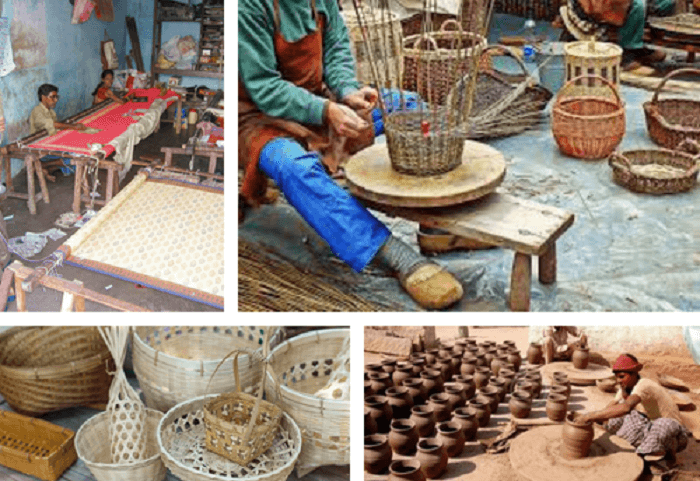Cottage IndustryWhat exactly is a Cottage Industry?A cottage industry is a small manufacturing enterprise owned and maintained by a person or a family, usually from a house rather than a purpose-built factory. Cottage businesses are distinguished by the little initial expenditure necessary to establish them. They frequently concentrate on making labour-intensive items, but they are at a significant disadvantage when competing with factory-based makers of mass-produced goods. 
What is the meaning of 'Cottage Industries'?Cottage industries may have been the first distant work system. Prior to the Industrial Revolution, they provided a means for people living in rural regions to earn a livelihood by performing labour-intensive tasks such as spinning wool, tanning leather, and making garments. They were frequently subcontractors, completing items and delivering them to firms that packed them for transportation to suppliers and retailers. This job was generally done in cottages in Europe and America, primarily by women who did not have access to other skills or professions. HistoryRural families were among the first to participate in the cottage industry. They supplemented their farming income by producing goods at home. Merchants supplied the raw ingredients to the households, collected and marketed the final product, and then paid a percentage of the price charged to the end customer. Cloth or clothing, shoes, cigars, and hand-decorated objects were initially manufactured by these at-home workers. Around 1870, cottage industries emerged in cities, giving rise to the harsh tenement housing system. These packed, hazardous apartment complexes housed immigrant families. They usually made clothing for meagre wages. This arrangement lasted until roughly 1920, when improved factory management rendered domestically manufactured items less competitive. Hand-decorating, stitching, and other highly specialized tasks are still carried out as cottage enterprises today. Economists point to the growth of a new cottage industry in which people can work from home on their computers instead of going to the office. A telecommuter is another name for home-based workers that are becoming more popular. Many jobs that used to necessitate employees' physical presence in the office can now be done from home. Today, all you need to run a business from home is a couple of phone lines with call forwarding and call waiting, a computer with e-mail and a modem, a fax machine, a copier, and office supplies. For CEOs on the move, a cell phone and a laptop computer can keep them connected from almost any location. How do Cottage Industries function?The early cottage industries in the United States and Europe subcontracted light manufacturing activities such as garment-making, textiles, or stitching, as well as shoemaking and tiny metal machine components. In many cases, these cottage enterprises used raw materials supplied by the contract provider to make completed items. Many modern companies now operate in factories, supplanted cottage industries that thrived before the Industrial Revolution in industrialized countries. Modern cottage industries cater to a consumer market that prefers unique, handcrafted items to mass-produced, name-brand items. These might range from garments to crafts to decorative home furniture. What are some of the advantages and disadvantages of cottage industries?
Cottage businesses can prosper if their owners are satisfied with remaining small producers in a specialized market, working for the benefit of a single family. Business expansion is conceivable, but there are substantial obstacles. Let us now explore the notable advantages and disadvantages of the cottage industry: Advantages
Disadvantages
What is the state of India's cottage industry?India boasts one of the world's oldest and most widespread cottage industries. The dynamic and diverse products that the sector produces for the market represent the country's diversity. Leather manufacture, silk weaving, cotton weaving, small-scale food processing such as pickles, finely done metal handicrafts, and carpet making are India's top five cottage industries. Cottage industries in India have undergone extensive research to better understand their characteristics. They discovered that the leather sector provides 12.9% of worldwide leather demand, with an annual production of 3 billion square feet. Furthermore, the tanning business employs about 4 million people, with women accounting for 30% of the labour force. Most completed goods are exported abroad, with the United States, Germany, and the United Kingdom accounting for about 40% of total export value. West Bengal, Uttar Pradesh, Haryana, and Tamil Nadu are the largest leather-producing states. The cotton weaving and textiles business in India also has a long history. After agriculture, the textile sector is India's second-largest employer. It supports about 51 million direct employments and provides over 5% of India's GDP. Some of India's largest cotton-producing states are Karnataka, Telangana, Maharashtra, and Gujarat. The silk weaving business primarily serves the demand for silk garments during the wedding and festival seasons. Karnataka accounts for 70% of India's silk weaving, with the main kinds being Mulberry, Eri, and Muga. Metal handicrafts and carpet manufacturing are specialized businesses requiring semi-skilled workers. Furthermore, these two sectors have an ethnic flavour in the places where they have historically dominated the economic scene. Overall, the rural Indian economy has benefited from the small-scale manufacturing industry. Such businesses also create jobs and generate a lot of money in foreign currencies. What are the issues that this industry is facing?The small-scale sector contributes to the economy but is plagued by several issues. The following are some of the significant issues: Skilled Labour Migration to CitiesSince the post-industrialization rise in cities, many rural cottage industries have seen a considerable drop in their available talent pool owing to the brain drain of trained and semi-skilled workers seeking better prospects. Industrial Houses CompetitorsCottage industries are severely constrained in size due to their inability to leverage economies of scale and high input prices. As a result, it is common for many small-business owners to operate on razor-thin margins. That does not bode well when a major corporation enters the area and starts mass-producing the same things at reduced prices. Ineffective Logistics and Poor Banking ServicesOperating within the country typically means lower startup expenses, but this is a double-edged sword. Delivering supplies to purchase houses is a logistical issue in impoverished nations where the road network is uneven and poorly maintained. This makes the delivery process somewhat difficult. Furthermore, small-scale business owners do not typically have easy access to low-interest borrowing that their bigger competitors do. Middlemen's Market Cornering and Predatory PracticesSetting up a business as a small manufacturer who has spent most of his life in a hamlet is easier if he has a consistent consumer. Sometimes, after weeks of searching, one may locate a customer prepared to acquire the total production capacity. However, there is a catch: the buyer will only pay the cost of running the firm, not the other costs involved. So, what would one do in this kind of situation? Unfortunately, this is the reality that innumerable small-scale enterprises face daily. Because there are few consumers but many producers and manufacturers, their fragmented nature works against them. DigitizationBecause most small-scale cottage businesses are usually not tech-driven, they cannot benefit from e-commerce and internet market potential. Furthermore, many local businesses have seen falling revenues, with consumer purchasing patterns preferring online purchases. They have been forced to close their doors. However, new-generation cottage entrepreneurs have been upskilling themselves and their business operations to sell online and bring improved efficiency into their enterprises in recent years. What are the opportunities in Cottage Industry?Niche markets that are unappealing to large manufacturers might be perfect for cottage companies. Competitive dancers, figure skaters, and other performers frequently use handcrafted costumes. Parents may make outfits for their children at the lowest levels of youth competition. As performers advance to higher levels of competition, the need for higher-quality costumes rises, offering chances for the most experienced costume designers to meet the demand. Designers who begin by making costumes for their own children and perhaps a few others may find themselves with a tiny industry after some time and experience. Can cottage industries be scaled?Cottage industries, by definition, are not usually scalable. Once they reach a specific size, they are no longer considered cottage enterprises. Success is defined differently by each individual. Most cottage companies are designed to provide a reasonable living for a single person or family. The occasional breakout star, such as Burt's Bees, began when a frustrated photojournalist chose to relocate to rural Maine and become a beekeeper. Burt, too, needed a partner with higher goals. The Bottom LineCottage industries flourished during the pre-Industrial era, when individuals in isolated places could make a living, although a difficult one, by creating labour-intensive items for more prominent firms. They appear to prosper in current times, with specialist enterprises springing up in homes worldwide to meet the need for high-quality handiwork. |
 For Videos Join Our Youtube Channel: Join Now
For Videos Join Our Youtube Channel: Join Now
Feedback
- Send your Feedback to [email protected]
Help Others, Please Share









